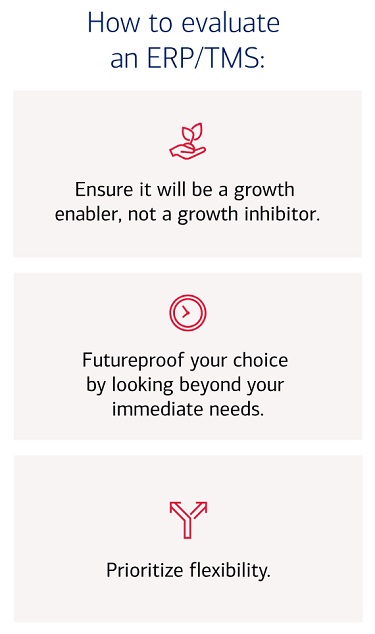Choosing the right treasury integration strategy
Deciding on an approach isn’t a purely technical decision. It also depends on the level of connectivity you need now and further down the line.
7 minute read
Key Takeaways
- The right ERP/TMS for your business depends on your current structure, where you operate and your plans for the future.
- In a rapidly changing environment, evaluate what your new platform will need to accomplish.
- Find trusted partners who can offer guidance and insights to help you navigate the latest solutions.
Is your organization evaluating an Enterprise Resource Planning (ERP) solution and/or a Treasury Management System (TMS)? Are you also assessing which fintech offering would further complement the solution set you are after? These help companies streamline business operations and accounting and help make more informed decisions by managing information more efficiently and gaining visibility into incoming and outgoing transaction flows. But the kind of platform and provider you need really depends on your business and your vision for the future. This article is intended to provide a framework for making key decisions.
A rapidly changing landscape
We’re seeing an increasing number of corporates adopting APIs and implementing transformation programs as businesses are looking at their technology and treasury product roadmaps and seeing where there’s room for improvement. They’re also navigating an industry-wide move toward standardization around ISO XML, ongoing discussions about legal entity identifiers for transactions and payments, and new payment processing and account validation rules that are planned or in place in the U.S., U.K., and the SEPA region. Meanwhile, fintechs are working hard to come up with interesting, innovative solutions.
More than just a technical decision
In this rapidly changing environment, it’s important to think about the challenges and opportunities you face and what your chosen solution will need to do. Don’t fall into the trap of tailoring your choices to the technology that you’re using now. Down the line, you may find that your ERP/TMS no longer works for your business model, becoming a growth inhibitor rather than a growth enabler. What can help at the outset is asking yourself the right questions:
- What level of complexity will your new platform need to handle?
This depends on where you are now, and where you’d like to be. If your company operates in a single country, you’ll have different needs than a multinational corporation, especially in terms of the number of banking relationships maintained. This directly impacts the level of complexity an ERP or TMS will face, including multiple integrations and incorporating domestic banks in various countries. - Will it enable robust reporting and controls?
Robust reporting around payment and receivables activity is key. You’ll also need to ensure that your new platform has a built-in approvals process that fully meets your needs. Access and entitlement management are important factors. For example, can your solution handle multiple hierarchies? Who can initiate or approve? - Can your system support different payment formats?
Currently the banking industry is working with Swift MT, but the recent introduction of XML-related formatting is an important development, and regulations coming into force are likely to mean a more structured approach going forward. With this in mind, your platform needs to not only support industry-standard formats like XML, but also incorporate local formats if you want to do business in other regions. - What will give you greater visibility across the organization?
Visibility over receivables helps treasurers understand whether invoices are correctly matched with bank statements. Having a single document generated from an ERP that gives a snapshot of transactions in any given period can help with this oversight. A tool like CashPro Forecasting from Bank of America, which partners with multiple large-scale ERP and TMS providers, can enhance this, automatically generating forecasts and refining them based on actual cashflows. - What level of connectivity do you need, now and in the future?
Consider different connectivity options and their associated cost and use case. Any successful solution should not only be able to handle a file but should also be capable of giving online access and accommodating APIs. However, it’s still good to ask, what do we need at this stage of our growth? For example, do we really need to implement APIs right now for real-time, urgent payments? That’s not to say you don’t need to prepare for greater complexity — as the business grows, you want to be able to use the same tools you’re investing in now or make only minor upgrades. - Will your EPS/TMS grow and scale with you?
Don’t simply solve for today’s problems. Instead, be intentional and look at the functionalities you might require in the future. For example, can the platform handle increased data volume and user numbers? Does it have the analytical tools that can create the insights that could become important to you? - Is it flexible?
We see more and more collaboration between clients and fintechs and choosing an ERP/TMS that’s flexible enough to work with these partners is crucial. For example, you may decide to use a fintech to outsource part of your payment processing, but the data from those transactions will eventually need to be integrated back into your core platform. In this case, a modular solution could be a good choice.

Finding the right partners
Once you’ve got a clear idea of what you want from your platform, finding the right partners is key. A trusted banking partner, who should be engaged as early as possible in the process, is essential. They can act as a consultant — you’ll be able to turn to a team of experts for the latest developments in the market or insights into vendors — and they’ll be with you for the entire journey.
For more information on how we can help, talk to your relationship manager.

Anna Popczynska | Director, Treasury Product Manager, Bank of America

Rene Schuurman | Director, CashPro Product Manager, Bank of America
Global Payments Solutions
Powered by people. Driven by technology




